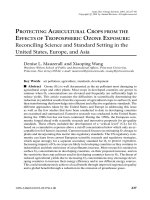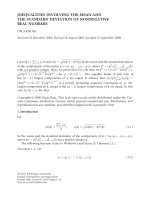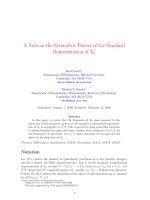Standard edition of the complete psychological works of sigmund freud vol 11
Bạn đang xem bản rút gọn của tài liệu. Xem và tải ngay bản đầy đủ của tài liệu tại đây (21.37 MB, 273 trang )
THE STANDARD EDITION OF
THE COMPLETE PSYCHOLOGICAL WORKS
OF SIGMUND FREUD
*
VOLUME XI
LEONARDO'S MADONNA AND CHILD WITH ST. ANNE
THE STANDARD EDITION
OF THE COMPLETE PSYCHOLOGICAL WORKS OF
SIGMUND FREUD
Translated from the German under the General Editorship of
JAMES STRACHEY
In Collaboration with
ANNA FREUD
Assisted by
ALIX STRACHEY and ALAN TYSON
VOLUME XI
(1910)
Five Lectures on Psycho-Analysis
Leonardo da Vinci
and
Other Works
LONDON
THE HOG AR TH PRESS
AND THE INSTITUTE OF PSYCHO-ANALYSIS
PUBLISHED BY
THE HOGARTH PRESS LIMITED
LEONARDO DA VINCI AND A MEMORY OP HIS CHILDHOOD
INCLUDED BY ARRANGEMENT WITH
ROUTLEDGE AND KEOAN PAUL LTD.
LONDON
*
CLARKE, IRWIN AND CO, LTD.
TORONTO
This Edition first Published in
ISBN O
7012 0067 7
All rights reserved. No part of this publication may be reproduced, stored in a retrieval
system, or transmitted, in any form, or by
any means, electronic, mechanical, photocopying, recording or otherwise, without the
prior permission of The Hogarth Press Ltd.
TRANSLATION AND EDITORIAL MATTER
@ THE INSTITUTE OP PSYCHO-ANALYSIS
AND ANGELA RICHARDS
1957
PRINTED AND BOUND IN GREAT BRITAIN
BY BUTLER AND TANNER LTD,, PROMB
CONTENTS
VOLUME ELEVEN
FIVE LECTURES ON PSYCHO-ANALYSIS
(1910 [1909])
Editor's Note
First Lecture
Second Lecture
Third Lecture
Fourth Lecture
Fifth Lecture
APPENDIX: List of Freud's Expository Works
page 3
9
21
29
40
49
56
LEONARDO DA VINCI AND A MEMORY OF
HIS CHILDHOOD
(1910)
Editor's Note
Leonardo da Vinci and a Memory of his Childhood
59
63
THE FUTURE PROSPECTS OF PSYCHO-ANALYTIC
THERAPY (1910)
139
THE ANTITHETICAL MEANING OF PRIMAL WORDS
(1910)
153
A SPECIAL TYPE OF CHOICE OF OBJECT MADE BY
MEN (CONTRIBUTIONS TO THE PSYCHOLOGY
OF LOVE I) (1910)
163
ON THE UNIVERSAL TENDENCY TO DEBASEMENT
IN THE SPHERE OF LOVE (CONTRIBUTIONS
TO THE PSYCHOLOGY OF LOVE II) (1912)
177
THE TABOO OF VIRGINITY (CONTRIBUTIONS TO
THE PSYCHOLOGY OF LOVE 111) (1918 [1917]) 191
THE PSYCHO-ANALYTIC VIEW OF PSYCHOGENIC
DISTURBANCE OF VISION (1910)
209
WILD' PSYCHO-ANALYSIS (1910)
V
219
CONTENTS
vi
SHORTER WRITINGS (1910)
page 231
Contributions to a Discussion on Suicide
Letter to Dr. Friedrich S. Krauss on Anthropophyteia
233
Two Instances of Pathogenic Phantasies Revealed by the
236
Patients Themselves
238
Review of Wilhelm Neutra's Letters to Neurotic Women
239
249
251
BIBLIOGRAPHY AND AUTHOR INDEX
LIST OF ABBREVIATIONS
GENERAL INDEX
LIST OF ILLUSTRATIONS
Leonardo's Madonna and Child with St. Anne
Leonardo's Mona Lisa
Frontispiece
facing page 107
FIVE LECTURES ON PSYCHO-ANALYSIS
,.
I
(1910 [1909])
EDITOR'S NOTE
OBER PSYCHOANALYSE
(a) GERMAN EDITIONS:
1910 Leipzig and Vienna: Deuticke. Pp. 62. (2nd ed. 1912,
3rd ed. 1916, 4th ed. 1919, 5th ed. 1920, 6th ed. 1922,
7th ed. 1924, 8th ed. 1930; all unchanged.)
1924 G.S., 4, 349-406. (Slightly changed.)
1943 G.W., 8, 3-60. (Unchanged from G.S.)
(b)
ENGLISH TRANSLATION:
'The Origin and Development of Psychoanalysis'
1910 Am. J. Psycho[., 21 (2 and 3), 181-218. (Tr. H. W.
Chase.)
1910 In Lectures and Addresses Delivered before the Departments of
Psychology and Pedagogy in Celebration of the Twentieth
Anniversary of the Opening of Clark Universiry, Worcester,
Mass., Part I, pp. 1-38. (Reprint of above.)
1924 In An Outline of Psychoanalysis, ed. Van Teslaar, New
York: Boni and Liveright. Pp. 21-70. (Re-issue of
above.)
The present, entirely new translation, with the different title
Five Lectures on Psycho-Analysis, is by James Strachey.
In 1909, Clark University, Worcester, Massachusetts, celebrated the twentieth year of its foundation, and its President,
Dr. G. Stanley Hall, invited Freud and some of his principal
followers (C. G. Jung, S. Ferenczi, Ernest Jones, and A. A.
Brill) to take part in the occasion and to be awarded honorary
degrees. It was in December, 1908, that Freud first received the
invitation, but it was not until the following autumn that the
event took place, and Freud's five lectures were delivered on
Monday, September 6, 1909, and the four following days. This,
as Freud himself declared at the time, was the first official
recognition of the young science, and he has described in his
3
4
FIVE LECTURES ON PSYCHO-ANALYSIS
Autobiographical Study (1925d, Chapter V) how, as he stepped on
to the platform to deliver his lectures, 'it seemed like the realization of some incredible day-dream' . 1
The lectures (in German, of course) were, according to
Freud's almost universal practice, delivered extempore and, as
we learn from Dr. Jones, without notes and after very little
preparation. It was only after his return to Vienna that he was
induced unwillingly to write them out. This work was not
finished till the second week of December, but his verbal
memory was so good that, as Dr. Jones assures us, the printed
version 'did not depart much from the original delivery'. Their
first publication was in an English translation in the American
Journal of Psychology early in 1910, but the original German
appeared soon afterwards as a pamphlet in Vienna. 2 The work
proved a popular one and it passed through several editions; in
none of these, however, was any alteration of substance made,
except for the footnote added in 1923 at the very beginning,
and appearing in the Gesammelte Schriften and Gesammelte Werke
only, in which Freud retracted his expressions of indebtedness
to Breuer. Some discussion of Freud's varying attitude to
Breuer will be found in the Editor's Introduction to Studies on
Hysteria, Standard Ed., 2, xxvi ff.
All through his career Freud was constantly ready to give
expositions ofhis discoveries. (A list of these will be found below,
on p. 56.) He had already published some short accounts of
psycho-analysis, but this set of lectures was the first on an extended scale. These expositions naturally varied in difficulty
according to the audience for which they were designed, and
this must be reckoned among the simplest ones, especially when
compared with the great series of Introductory Lectures delivered
a few years later (1916-17). Nevertheless, in spite of all the
additions that were to be made to the structure of psychoanalysis during the following quarter of a century, these lectures
1 Another account of the occasion will be found in the 'History of the
Psycho-Analytic Movement' (1914d). A fuller description, from which
most of the details given here are derived, is contained in EmestJones's
biography (1955, 59 ff.).
1 During Freud's lifetime the lectures were translated into many other
languages: Polish (1911), Russian (1911), Hungarian (1912), Dutch
(1912), Italian (1915), Danish (1920), French (1921), Spanish (1923),
Portuguese (1931), andJapanese (1933).
-·
EDITOR'S NOTE
5
still provide an admirable preliminary picture which calls for
very little correction. And they give an excellent idea of the ease
and clarity of style and the unconstrained sense of form which
made Freud such a remarkable expository lecturer.
Considerable extracts from the earlier (1910) translation of
this work were included in Rickman's General Selection from the
Works of Sigmund Freud (1937, 3-43).
I
FIVE LECTURES ON
PSYCHO-ANALYSIS
Delivered on the Occasion of the Celebration
of the Twentieth Anniversary of the Foundation
of
CLARK UNIVERSITY, WORCESTER
MASSACHUSETTS
September 1909
To
DR. G. STANLEY HALL, PH.D., LL.D.
President of Clark University
Professor of Psychology and Pedagogics
This Work is Gratefully Dedicated
FIRST LECTURE
LADms AND GENTLEMEN,-It is with novel and bewildering
feelings that I find myself in the New World, lecturing before
an audience of expectant enquirers. No doubt I owe this honour
only to the fact that my name is linked with the topic of psychoanalysis; and it is of psycho-analysis, therefore, that I intend to
speak to you. I shall attempt to give you, as succinctly as possible, a survey of the history and subsequent development of
this new method of examination and treatment.
If it is a merit to have brought psycho-analysis into being,
that merit is not mine. 1 I had no share in its earliest beginnings.
I was a student and working for my final examinations at the
time when another Viennese physician, Dr.JosefBreuer, 2 first
(in 1880-2) made use of this procedure on a girl who was
suffering from hysteria. Let us turn our attention straightaway
to the history of this case and its treatment, which you will find
set out in detail in the Studies on Hysteria [1895d] 3 which were
published later by Breuer and myself.
But I should like to make one preliminary remark. It is not
without satisfaction that I have learnt that the majority of my
audience are not members of the medical profession. You have
no need to be afraid that any special medical knowledge will be
required _for following what I have to say. It is true that we
1 (Footnote added 1923:) See, however, in this connection my remarks
in 'A History of the Psycho-Analytic Movement' (1914d), where I
assumed the entire responsibility for psycho-analysis.
2
Dr. Josef Breuer, born in 1842, a Corresponding Member of the
Kaiserliche Akademie der Wissenschaften [Imperial Academy of
Sciences], is well known for his work on respiration and on the physiology of the sense of equilibrium. [His obituary by Freud (1925g) included a more detailed account of his career.]
8 Some of my contributions to this book have been translated into
English by Dr. A. A. Brill of New York: Selected Papers on Hysteria (New
York, 1909). [This was the first Freud book to appear in English. The
complete Breuer and Freud Studies were translated by Brill later (New
York, 1936). A new translation appeared in 1955, forming the second
volume of the Freud Standard Edition, where the case history of this
patient (Fraulein Anna 0.) will be found on p. 21 ff.]
9
10
FIVE LECTURES ON PSYCHO-ANALYSIS
shall go along with the doctors on the first stage of our journey,
but we shall soon part company with them and, with Dr. Breuer,
shall pursue a quite individual path.
Dr. Breuer's patient was a girl of twenty-one, of high intellectual gifts. Her illness lasted for over two years, and in the
course of it she developed a series of physical and psychological
disturbances which decidedly deserved to be taken seriously.
She suffered from a rigid paralysis, accompanied by loss of
sensation, of both extremities on the right side of her body; and
the same trouble from time to time affected her on her left side.
Her eye movements were disturbed and her power of vision was
subject to numerous restrictions. She had difficulties over the
posture of her head; she had a severe nervous cough. She had
an aversion to taking nourishment, and on one occasion she was
for several weeks unable to drink in spite of a tormenting thirst.
Her powers of speech were reduced, even to the point of her
being unable to speak or understand her native language.
Finally, she was subject to conditions of 'absence', 1 of confusion,
of delirium, and of alteration of her whole personality, to which
we shall have presently to turn our attention.
When you hear such an enumeration of symptoms, you will
be inclined to think it safe to assume, even though you are not
doctors, that what we have before us is a severe illness, probably
affecting the brain, that it offers small prospect of recovery and
will probably lead to the patient's early decease. You must be
prepared to learn from the doctors, however, that, in a number
of cases which display severe symptoms such as these, it is
justifiable to take a different and a far more favourable view.
If a picture of this kind is presented by a young patient of the
female sex, whose vital internal organs (heart, kidneys, etc.) are
shown on objective examination to be normal, but who has been
subjected to violent emotional shocks-if, moreover, her various
symptoms differ in certain matters of detail from what would
have been expected-then doctors are not inclined to take the
case too seriously. They decide that what they have before them "
is not an organic disease of the brain, but the enigmatic condition which, from the time of ancient Greek medicine, has been
known as 'hysteria' and which has the power of producing
illusory pictures of a whole number of serious diseases. They
1
(The French term.]
FIRST LECTURE
11
consider that there is then no risk to life but that a return to
health-even a complete one-is probable. It is not always
quite easy to distinguish a hysteria like this from a severe
organic illness. There is no need for us to know, however, how
a differential diagnosis of that kind is made; it will suffice to
have an assurance that the case of Breuer's patient was precisely of a kind in which no competent physician could fail to
make a diagnosis of hysteria. And here we may quote from the
report of the patient's illness the further fact that it made its
appearance at a time when she was nursing her father, of whom
she was devotedly fond, through the grave illness which led to
his death, and that, as a result of her own illness, she was obliged
to give up nursing him.
So far it has been an advantage to us to accompany the
doctors; but the moment of parting is at hand. For you must
not suppose that a patient's prospects of medical assistance are
improved in essentials by the fact that a diagnosis of hysteria
has been substituted for one of severe organic disease of the
brain. Medical skill is in most cases powerless against severe
diseases of the brain; but neither can the doctor do anything
against hysterical disorders. He must leave it to kindly Nature
to decide when and how his optimistic prognosis shall be fulfilled.1
Thus the recognition of the illness as hysteria makes little
difference to the patient; but to the doctor quite the reverse.
It is noticeable that his attitude towards hysterical patients is
quite other than towards sufferers from organic diseases. He
does not have the same sympathy for the former as for the
latter: for the hysteric's ailment is in fact far less serious and
yet it seems to claim to be regarded as equally so. And there is
a further factor at work. Through his studies, the doctor has
learnt many things that remain a sealed book to the layman:
he has been able to form ideas on the causes of illness and on the
changes it brings about-e.g. in the brain of a person suffering
from apoplexy or from a malignant growth-ideas which must
to some degree meet the case, since they allow him to understand
1
I am aware that this is no longer the case; but in my lecture I am
putting myself and my hearers back into the period before 1880. If
things are different now, that is to a great extent the result of the
activities whose history I am now sketching.
S.F.XI-B
,__.-------------12
FIVE LECTURES ON PSYCHO-ANALYSIS
the details of the illness. But all his knowledge-his training in anatomy, in physiology and in pathology-leaves him in
the lurch when he is confronted by the details of hysterical
phenomena. He cannot understand hysteria, and in the face of
it he is himself a layman. This is not a pleasant situation for
anyone who as a rule sets so much store by his knowledge. So it
comes about that hysterical patients forfeit his sympathy. He
regards them. as people who are transgressing the laws of his
science-like heretics in the eyes of the orthodox. He attributes
every kind of wickedness to them, accuses them of exaggeration,
of deliberate deceit, of malingering. And he punishes them by
withdrawing his interest from them.
Dr. Breuer's attitude towards his patient deserved no such
reproach. He gave her both sympathy and interest, even
though, to begin with, he did not know how to help her. It
seems likely that she herself made his task easier by the admirable qualities of intellect and character to which he has testified
in her case history. Soon, moreover, his benevolent scrutiny
showed him the means of bringing her a first instalment of
help.
It was observed that, while the patient was in her states of
'absence' (altered personality accompanied by confusion), she
was in the habit of muttering a few words to herself which
seemed as though they arose from some train of thought that
was occupying her mind. The doctor, after getting a report of
these words, used to put her into a kind of hypnosis and then
repeat them to her so as to induce her to use them as a startingpoint. The patient complied with the plan, and in this way
reproduced in his presence the mental creations which had been
occupying her mind during the 'absences' and which had betrayed their existence by the fragmentary words which she had
uttered. They were profoundly melancholy phantasies-'daydreams' we should call them-sometimes characterized by
poetic beauty, and their starting-point was as a rule the position
of a girl at her father's sick-bed. When she had related a number of these phantasies, she was as if set free, and she was
brought back to normal mental life. The improvement in her
condition, which would last for several hours, would be succeeded next day by a further attack of'absence'; and this in turn
would be removed in the same way by getting her to put into
I
FIRST LECTURE
13
words her freshly constructed phantasies. It was impossible to
escape the conclusion that the alteration in her mental state
which was expressed in the 'absences' was a result of the stimulus
proceeding from these highly emotional phantasies. The patient
herself, who, strange to say, could at this time only speak and
understand English, christened this novel kind of treatment the
'talking cure' 1 or used to refer to it jokingly as 'chimneysweeping' . 1
It soon emerged, as though by chance, that this process of
sweeping the mind clean could accomplish more than the
merely temporary relief of her ever-recurring mental confusion.
It was actually possible to bring about the disappearance of the
painful symptoms of her illness, if she could be brought to
remember under hypnosis, with an accompanying expression of
affect, on what occasion and in what connection the symptoms
had first appeared. 'It was in the summer during a period of
extreme heat, and the patient was suffering very badly from
thirst; for, without being able to account for it in any way, she
suddenly found it impossible to drink. She would take up the
glass of water that she longed for, but as soon as it touched her
lips she would push it away like someone suffering from hydrophobia. As she did this, she was obviously in an absence for a
couple of seconds. She lived only on fruit, such as melons, etc.,
so as to lessen her tormenting thirst. This had lasted for some
six weeks, when one day during hypnosis she grumbled about
her English "lady-companion", whom she did not care for, and
went on to describe, with every sign of disgust, how she had once
gone into this lady's room and how her little dog-horrid
creature!-had drunk out of a glass there. The patient had said
nothing, as she had wanted to be polite. After giving further
ene{getic expression to the anger she had held back, she asked
for something to drink, drank a large quantity of water without
any difficulty, and awoke from her hypnosis with the glass at her
lips; and thereupon the disturbance vanished, never to return.' 1
With your permission, I should like to pause a moment over
this event. Never before had anyone removed a hysterical
symptom by such a method or had thus gained so deep an
insight into its causation. It could not fail to prove a momentous
1
2
[These phrases are in English in the original.]
Studies on Hysteria [Standard Ed., 2, 34].
14
FIVE LECTURES ON PSYCHO-ANALYSIS
discovery if the expectation were confirmed that others of the
patient's symptoms-perhaps the majority of them-had arisen
and could be removed in this same manner. Breuer spared no
pains in co:qvincing himself that this was so, and he proceeded
to a systematic investigation of the pathogenesis of the other and
more serious symptoms of the patient's illness. And it really was
so. Almost all the symptoms had arisen in this way as residues
-'precipitates' they might be called-of emotional experiences.
To these experiences, therefore, we later gave the name of
'psychical traumas', while the particular nature of the symptoms was explained by their relation to the traumatic scenes
which were their cause. They were, to use a technical term,
'determined' by the scenes of whose recollection they represented residues, and it was no longer necessary to describe
them as capricious or enigmatic products of the neurosis. One
unexpected point, however, must be noticed. What left the
symptom behind was not always a single experience. On the
contrary, the result was usually brought about by the convergence of several traumas, and often by the repetition of a great
number of similar ones. Thus it was necessary to reproduce the
whole chain of pathogenic memories in chronological order, or
rather in reversed order, the latest ones first and the earliest
ones last; and it was quite impossible to jump over the later
traumas in order to get back more quickly to the first, which was
often the most potent one.
No doubt you will now ask me for some further instances of
the causation of hysterical symptoms besides the one I have
already given you of a fear of water produced by disgust at a
dog drinking out of a glass. But if I am to keep to my programme I shall have to restrict myself to very few examples. In
regard to the patient's disturbances of vision, for instance,
Breuer describes how they were traced back to occasions such
as one on which, 'when she was sitting by her father's bedside
with tears in her eyes, he suddenly asked her what time it was.
She could not see clearly; she made a great effort, and brought
her watch near to her eyes. The face of the watch now seemed
very big-thus accounting for her macropsia and convergent
squint. Or again, she tried hard to suppress her tears so that the
sick man should not see them.' 1 Moreover, all of the patho1
Studies on Hysteria [Standard Ed., 2, 39-40].









